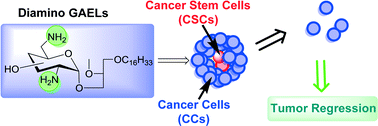Design, synthesis and evaluation of cytotoxic properties of bisamino glucosylated antitumor ether lipids against cancer cells and cancer stem cells†‡
Abstract
Glycosylated antitumor ether lipids (GAELs) are a class of amphiphilic antitumor agents that kill cancer cells by a non-apoptotic pathway. Previous studies have shown that 2-amino-2-deoxy-D-gluco-based GAELs such as α-GLN and β-GLN show greatly improved antitumor activity against epithelial cancer cells and stem cells. To further optimize the bioactivity, we prepared a series of diamino-D-gluco-based GAELs and their analogs, and screened them against a panel of human epithelial cancer cell lines and cancer stem cells. Most of the new GAEL analogs are more potent than chlorambucil, cisplatin and salinomycin. The most potent bisamine-based GAEL analogs 1, 2, 4 and 8 showed 2- to 3-fold enhanced cytotoxicity against various cancer cell lines when compared to β-GLN, indicating that the addition of a second amino group enhances the cytotoxic effect. The effect of the most active dicationic GAELs 1 and 4 on cancer stem cells isolated from breast (BT-474) and prostate (DU-145) cell lines revealed that the two GAELs inhibited the formation of tumor spheres and resulted in >95% loss of viability of the cancer stem cells at 5 μM. Activity of GAEL 1 against BT-474 cancer stem cells is superior to that of salinomycin.



 Please wait while we load your content...
Please wait while we load your content...